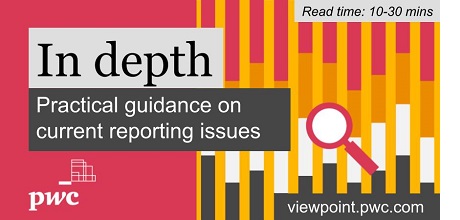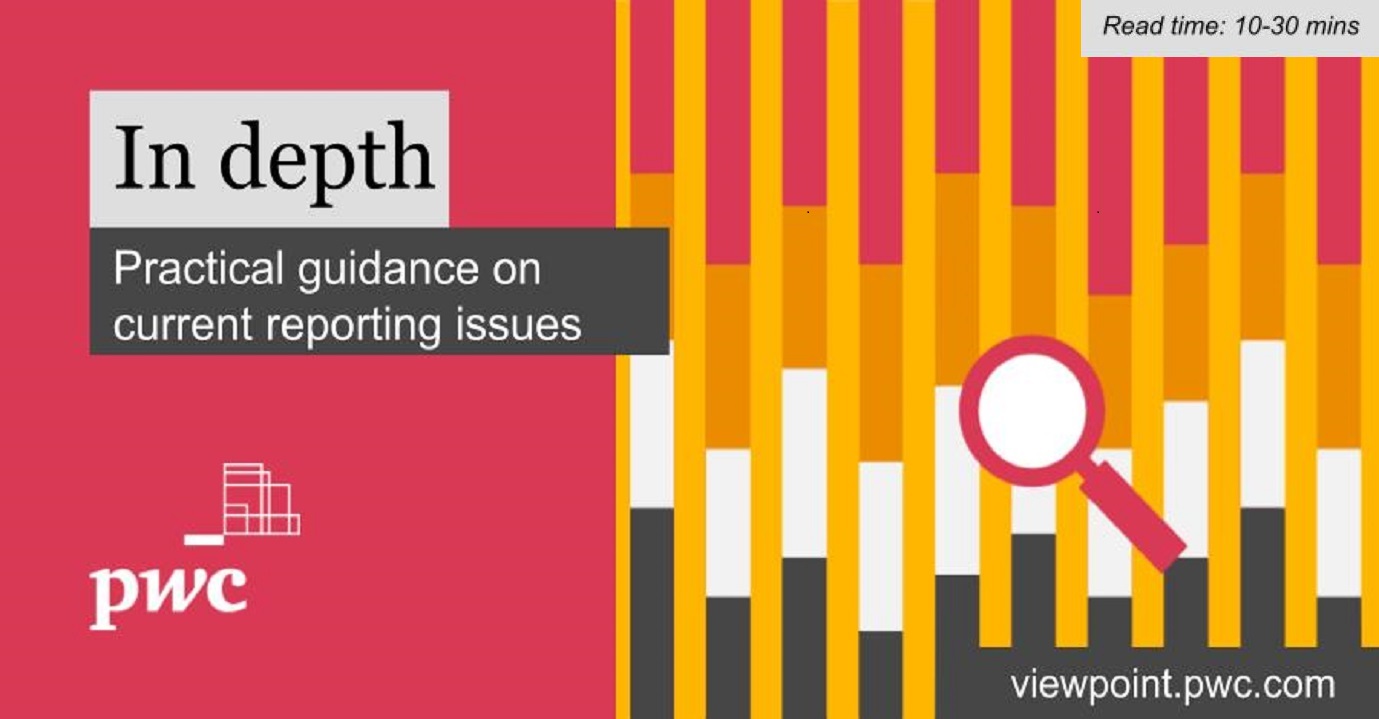Search within this section
Select a section below and enter your search term, or to search all click IFRS In depths

Favorited Content
Key points

What not to miss… |
Further guidance |
||
|---|---|---|---|
|
What are they?
They are contracts that require the issuer to make specified payments to reimburse the holder for a loss that it incurs if a specified debtor fails to make payment when due. Such contracts are outside the scope of IFRS 17 and within the scope of IFRS 9, unless the issuer has previously asserted explicitly that it regards such contracts as insurance contracts and has used the accounting guidance applicable to insurance contracts in the past under IFRS 4.
What is a common example?
A subsidiary might have obtained a loan from the bank, but the bank required a guarantee from its parent. The parent issued a financial guarantee to the bank, meaning that, if the subsidiary cannot repay the loan, the parent is contractually obliged to step in and make the payment to the bank. Note that a letter of support or comfort letter is not a financial guarantee.
What could I be missing?
Liabilities. Many parent entities applied IFRS 4 as a policy, as opposed to IFRS 9, and do not reflect financial guarantees issued on their balance sheets until a guarantee is triggered (that is, applying the IFRS 4 liability adequacy test, consistent with IAS 37 principles).
On transition to IFRS 17 from IFRS 4, an entity should apply the requirements in IFRS 17 for the first time and, consequently, it can choose to apply either IFRS 17 or IFRS 9 to such contracts. Given the complexities with IFRS 17 accounting, we expect that many non-insurers will choose to apply IFRS 9 instead. However, entities that are not already applying IFRS 9 to financial guarantees should be aware that significant work might be required to calculate the IFRS 9 liability. IFRS 9 requires a financial guarantee to be subsequently measured at the higher of (i) the IFRS 9 expected credit loss allowance and (ii) the initial fair value less any cumulative income. This could be a significant change in accounting policy that would need to be applied retrospectively.
So, subject to materiality consideration, under either IFRS 9 or IFRS 17, a liability for the guarantee might now need to be recognised.
Further guidance:
IFRS MoA chapter 40 paras 40.73 - 40.75 and FAQ 50A.27.1 |
||
What not to miss… |
Further guidance |
||
|---|---|---|---|
|
What are they?
An onerous contract is a contract in which the unavoidable costs of meeting the obligations under the contract exceed the economic benefits expected to be received. Unavoidable costs are the lower of the costs of fulfilling the contract and any compensation or penalties from the failure to fulfil it.
How can they arise?
Current uncertainty in the economic environment might impact an entity’s operations and result in an increased number of onerous contracts. For example, costs to deliver on existing revenue contracts might rise due to inflationary pressures, or benefits expected from existing purchasing contracts might fall due to lower demand, making it difficult to resell committed purchases at a profit.
What could I be missing?
Provisions. A provision might need to be recognised that currently is not. However, the term ‘economic benefits expected to be received’ should usually be construed to include both direct and indirect benefits under the contract. If a provision is required, this should be measured at the amount of ‘unavoidable costs’ under a contract; these are defined as being the least net cost of exiting the contract. This will be the lower of the cost to exit or breach the contract and the cost of fulfilling it. Finally, an entity should recognise any impairment that has occurred on assets used in fulfilling the contract before an onerous contract provision is recognised.
Further guidance:
IFRS MoA chapter 16 paras 16.71 - 16.85 |
||
What not to miss… |
Further guidance |
||
|---|---|---|---|
|
What are they?
Site restoration provisions should be made in respect of the estimated future costs of closure and restoration, and for environmental rehabilitation costs (which include the dismantling and demolition of infrastructure, removal of residual materials and remediation of disturbed areas) in the accounting period when the related environmental disturbance occurs.
How can they arise?
For example, some leases allow the tenant to improve the property by adding additional partitioning, but they include obligations on the lessee to return the property at the end of the lease to its original state. This might entail dismantling the improvements.
What could I be missing?
Provisions. Entities might have previously considered that options to renew the lease would be taken. If there is a change in circumstances such that, for example, leases will no longer be renewed, dismantling outflows might now materialise quicker than expected and perhaps become material for the first time so that a provision would need to be recognised.
Further guidance:
|
||
What not to miss… |
Further guidance |
||
|---|---|---|---|
|
What are they?
A share repurchase or buyback is a form of shareholder remuneration where companies buy back their own shares to reduce their capital.
How can they arise?
Often, entities enter into contracts with brokers or banks to acquire their own shares on their behalf.
What could I be missing?
Financial liabilities. Contracts containing an obligation for an entity to purchase its own equity instruments for cash or another financial asset give rise to a financial liability. The financial liability should be measured initially at the present value of the redemption amount (for example, for the present value of the forward repurchase price, option exercise price or other redemption amount). When the liability is recognised, the corresponding debit is to equity.
Further guidance:
|
||
What not to miss… |
Further guidance |
||
|---|---|---|---|
|
What are they?
Some entities have been designed so that voting or similar rights are not the dominant factor in deciding who controls them: voting rights might relate to administrative tasks only, and contractual arrangements dictate how the investee should carry out its activities; all substantive powers might appear to have been surrendered to contracts that impose rigid control of the entity’s activities; they might run on auto-pilot; none of the parties involved in the set-up might appear to have power; but the entities might be indirectly controlled by one of the parties involved.
How can they arise?
Such entities are typically set up with restricted activities, to achieve a certain narrowly defined objective and they often have thin capitalisation. They might have tax advantages and are sometimes limited in life to also achieve a specified financial objective.
What could I be missing?
Consolidation. When determining if a structured entity should be consolidated, one needs to consider the control criterion, which requires an investor to have the power to direct the relevant activities of the structured entity so as to obtain benefits. A key consideration is assessing the design and purpose of such a structured entity and whether the investor has exposure to the risks and rewards of the structured entity. Additionally, careful consideration of the rights of other parties involved, and determination of whether the investor has decision-making rights over the activities of the structured entity is needed.
Further guidance:
|
||
What not to miss… |
Further guidance |
||
|---|---|---|---|
|
What is it?
“Offsetting” or “netting” is the presentation of (i) net amounts of assets and liabilities in the balance sheet, (ii) income and expenses in the income statement, and / or (iii) cash flows in the cash flow statement.
What is the issue?
Offsetting and netting is generally prohibited, except where expressly required or permitted by accounting standards. This is because it detracts from the users’ ability both to gain a full and proper understanding of the underlying transactions, and to assess an entity’s future cash flows.
Where offsetting is expressly permitted, there are usually specific criteria that must be met in order to offset.
What could I be missing?
Assets and liabilities, income and expense items. Two amounts might have been incorrectly presented net in the balance sheet or income statement where they should have instead been presented gross.
Further guidance:
Specific guidance to offsetting by topic:
|
||
Topic |
Reference |
||
General offsetting, including in the income statement |
|||
Financial instruments |
|||
Provisions and reimbursements |
|||
Current and deferred tax |
|||
Cash flow statement |
|||
Defined benefit plans |
|||
Government grants |
|||
What not to miss… |
Further guidance |
||
|---|---|---|---|
|
What are they?
An implied lease refers to a situation where a contract does not explicitly state that it is a lease but where it contains terms and conditions that effectively create a lease arrangement.
How can they arise?
Arrangements might be entered into that do not take the legal form of a lease but they still convey rights to use identifiable assets in return for a payment or series of payments. Examples of such arrangements include service or supply contracts with dedicated equipment, outsourcing arrangements or telecommunication contracts that provide rights to substantially all of the asset’s capacity.
What could I be missing?
Right of use assets and lease liabilities. To fall into the scope of IFRS 16, there must be an identified asset. However, the asset does not have to be explicitly identified - it can be implicit. If implicit, the asset is not mentioned in the contract, but is implicitly specified in order for the supplier to provide the related goods or services. There is no identified asset if the supplier has a substantive right to substitute the asset throughout the period of use; and, for the contract to contain a lease, the customer must still have the right to obtain substantially all of the economic benefit from the use of the asset throughout the period of use, and to direct how and for what purpose the asset is used.
Further guidance:
|
||
What not to miss… |
Further guidance |
||
|---|---|---|---|
|
What are they?
If employees of a subsidiary have been awarded share-based payments by the parent, IFRS 2 requires a share-based payment charge to be recorded in the subsidiary.
What is the issue?
IFRS 2 requires entities to recognise the cost of share-based payment arrangements in respect of their employees even if the entity itself has no obligation to settle them (these would represent equity-settled share-based payment arrangements).
What could I be missing?
A share-based payment expense at the subsidiary separate financial statement level. These arrangements are common in private equity and group situations in which the parent is listed but the subsidiaries are not. In addition to the subsidiary recording the charge, if there is no recharge mechanism, the parent would typically increase its investment in the subsidiary through this scheme.
Further guidance:
|
||
© #year# PricewaterhouseCoopers LLP. This content is copyright protected. It is for your own use only - do not redistribute. These materials were downloaded from PwC's Viewpoint (viewpoint.pwc.com) under licence.
Any trademarks included are trademarks of their respective owners and are not affiliated with, nor endorsed by, PwC. PwC refers to the PwC network and/or one or more of its member firms, each of which is a separate legal entity. Please see www.pwc.com/structure for further details.

Select a section below and enter your search term, or to search all click IFRS In depths











